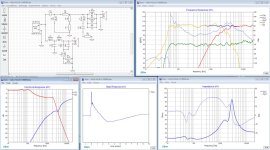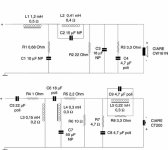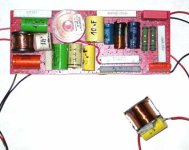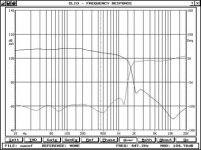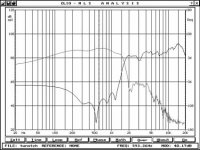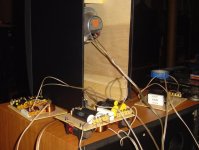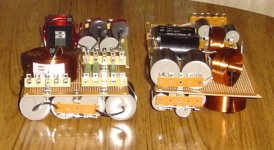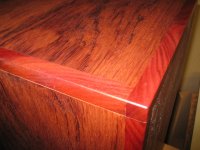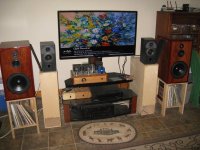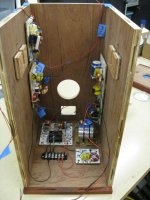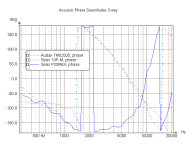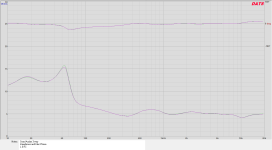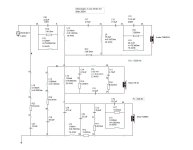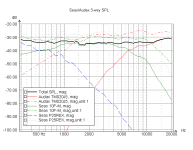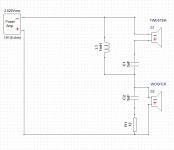So I'm making these speakers. And I'm going for this Harsch XO style. And by the time I get it set up it's gotten a little crazy. And it makes me think let's talk about complex crossover designs.


Thank goodness for wagos!
But then I think - ya know? I bet someone on DIYAudio has something way crazier than this. I mean, you could make a passive 4-way, do it 4th order, that'll be like 10,000 components NP. But a complicated 2 way gets respect also, I think. Total complexity, or complexity per band. You know what I mean. But implemented designs only! "I designed something but then didn't build it b/c it was insane" doesn't count. And also, passive - anyone can put 45 biquads in DSP if they wanna. If you actually built something crazy, why did you feel like it was worth it to go the extra mile?
Also, I was thinking about the possibility to build something like this before electrical simulation and measurement software were as good as they are today. So I welcome discussion of crossover complexity today vs. back in history. And, hobbyists may choose to pursue designs that wouldn't make sense commercially, so discussion about commercial XO's vs hobbyist decisions WRT complexity and motivation are also on-topic.
Who has some interesting stories?
Thank goodness for wagos!
But then I think - ya know? I bet someone on DIYAudio has something way crazier than this. I mean, you could make a passive 4-way, do it 4th order, that'll be like 10,000 components NP. But a complicated 2 way gets respect also, I think. Total complexity, or complexity per band. You know what I mean. But implemented designs only! "I designed something but then didn't build it b/c it was insane" doesn't count. And also, passive - anyone can put 45 biquads in DSP if they wanna. If you actually built something crazy, why did you feel like it was worth it to go the extra mile?
Also, I was thinking about the possibility to build something like this before electrical simulation and measurement software were as good as they are today. So I welcome discussion of crossover complexity today vs. back in history. And, hobbyists may choose to pursue designs that wouldn't make sense commercially, so discussion about commercial XO's vs hobbyist decisions WRT complexity and motivation are also on-topic.
Who has some interesting stories?
Attachments
I had a 2-way with very smooth drivers that I still ended up with probably 16 parts in the x-over. That was 24 years ago, and I was using filtered pink noise and measuring. Several experts of that time were telling me I was doing it wrong, however, it was well received at a speaker get together with about 40 attendees in a large room..The mentioned expert liked it.
I later removed the x-over, and looking at it, I couldn't even follow it. I could probably do that same x-over now with half that many parts.
I use only gated measurements these days. It looks like you are not.
I later removed the x-over, and looking at it, I couldn't even follow it. I could probably do that same x-over now with half that many parts.
I use only gated measurements these days. It looks like you are not.
Last edited:
I've assembled, and measured a 3-way with probably over 30 components using jumpers. I bailed on it after considering the work that would be involved assembling it. So as you say, it doesn't count.
Oh, by the way, both x-overs were done by trial and error without any sims. The 3-way using HOLM to measure. Now I use REW. Same results I think, but less mouse clicks are needed.
Oh, by the way, both x-overs were done by trial and error without any sims. The 3-way using HOLM to measure. Now I use REW. Same results I think, but less mouse clicks are needed.
Last edited:
If you want to post nice clean gated files, I like to play.
Can you give a quick explanation of the Harsch xo? You combine a steep filters on the woofer, and a shallow on the tweeter. Is there a specific slope, and offset involved? Is it 18dB, and 30dB slopes? I may have done something remotely similar by accident, but likely thought matching slopes were better, and I was compromising doing it otherwise. I have seen a pretty flat phase response a couple of times on my speakers. I just recently discovered how to look at the impulse in REW.
Can you give a quick explanation of the Harsch xo? You combine a steep filters on the woofer, and a shallow on the tweeter. Is there a specific slope, and offset involved? Is it 18dB, and 30dB slopes? I may have done something remotely similar by accident, but likely thought matching slopes were better, and I was compromising doing it otherwise. I have seen a pretty flat phase response a couple of times on my speakers. I just recently discovered how to look at the impulse in REW.
Last edited:
Happy to discuss my build or measurements in the thread for those speakers!
Link in the first post.
Link in the first post.
For a 4-Ways enclosure :

For a 3-Ways enclosure :

All are Serial / Parallel configurations.
The matching enclosures - the 4-Ways is still in listening test :

Aw, sorry - I thought it was the most simplistic you implemented... 🙄😉
T
For a 3-Ways enclosure :
All are Serial / Parallel configurations.
The matching enclosures - the 4-Ways is still in listening test :
Aw, sorry - I thought it was the most simplistic you implemented... 🙄😉
T
I have 25 parts in my Attitudes 3ways.
IIRC, I have 21 in the Cecropia Supreme 2 ways.
Of both above, it does not count the many superfluous parts I've been able to switch out within the circuits. I was testing audibility of the caps in the Attitudes and coils in the Cecropia Supreme via heavy duty toggle switches. They both were experiments that were well worth it.
14 in Monoculus 3ways.
20 on my Missing Links project 2way.
15 in my Pangolins 10" DVC 2way wired as 2.5way.
16 parts in my Bottleships micro 3way.
15 parts in my Purveyor small 3ways.
22 in my MAX 2ways.
Yeah, heavy parts count does happen!
IIRC, I have 21 in the Cecropia Supreme 2 ways.
Of both above, it does not count the many superfluous parts I've been able to switch out within the circuits. I was testing audibility of the caps in the Attitudes and coils in the Cecropia Supreme via heavy duty toggle switches. They both were experiments that were well worth it.
14 in Monoculus 3ways.
20 on my Missing Links project 2way.
15 in my Pangolins 10" DVC 2way wired as 2.5way.
16 parts in my Bottleships micro 3way.
15 parts in my Purveyor small 3ways.
22 in my MAX 2ways.
Yeah, heavy parts count does happen!
Some time ago I considered building "The Saffrons" TMM with Peerless 830656 mids and Vifa BC25TG tweeters; it won a 'Best Iron Driver' competition in 2012:
https://techtalk.parts-express.com/forum/tech-talk-forum/53275-iron-speaker-saffrons
I'm sure it would have sounded great, but the XO has 21 parts and my non-electronics brain couldn't cope with that. It was a great looking design, too with high WAF.
Geoff
https://techtalk.parts-express.com/forum/tech-talk-forum/53275-iron-speaker-saffrons
I'm sure it would have sounded great, but the XO has 21 parts and my non-electronics brain couldn't cope with that. It was a great looking design, too with high WAF.
Geoff
And it makes me think let's talk about complex crossover designs.
Who has some interesting stories?
Once upon a time I build this (pictures)
I was reading the Jason Cuadra paper about the extreme slope xover, and wanted to give it a try.
It worked as intended.
Attachments
Last edited:
Well, the horn itself was decently linear phase except the tweeter, had to hold it back somehow. I don't know that it made any audible difference, but it was an exercise.
I finished a 3-way series last year with 28 components.
It was an exercise in using up some old stock in my stash. A few resonances needed taming.
Rear port was stuffed to alleviate the woofer's boominess.
With some impedance compensation, the load above 100 Hz is nearly resistive. Acoustic phase is excellent.
Bubinga ply with cocobolo edges. Pleasing to the ears and eyes.
It was an exercise in using up some old stock in my stash. A few resonances needed taming.
Rear port was stuffed to alleviate the woofer's boominess.
With some impedance compensation, the load above 100 Hz is nearly resistive. Acoustic phase is excellent.
Bubinga ply with cocobolo edges. Pleasing to the ears and eyes.
Attachments
Last edited:
For a 4-Ways enclosure :

Is that FOUR ways crossover with so little components????!!!!
Does this project have separate thread? I need to follow genius designs like this.
I always admired the complexity of this one...
How it measures/sounds? Like cheap Polk or like accidental gold nugget?
Have you a link I could follow? I did a quick search but maybe Max is too general a term. Or point me at whichever design you wish to center...22 in my MAX 2ways.
ooo, also a link? I found reference to his name, but not the paper.I was reading the Jason Cuadra paper about the extreme slope xove
Seeing a big part count / schematic is impressive, but a bit of understanding about why it got so complicated is the interesting part! Thx for the additional comment.the horn itself was decently linear phase except the tweeter, had to hold it back somehow
Series! Bravo, sir. I will have to play with a series XO at some point. That plywood sure looks the biz also.I finished a 3-way series last year with 28 components.
Aw, sorry - I thought it was the most simplistic you implemented... 🙄😉
I always admired the complexity of this one...
Is that FOUR ways crossover with so little components????!!!!
Oi! You minimalists get your own thread! 🤣😆🤣😆
Opposite extremities attract each other! 😆Oi! You minimalists get your own thread! 🤣😆🤣😆
- Home
- Loudspeakers
- Multi-Way
- What is the most complex crossover you've implemented?
